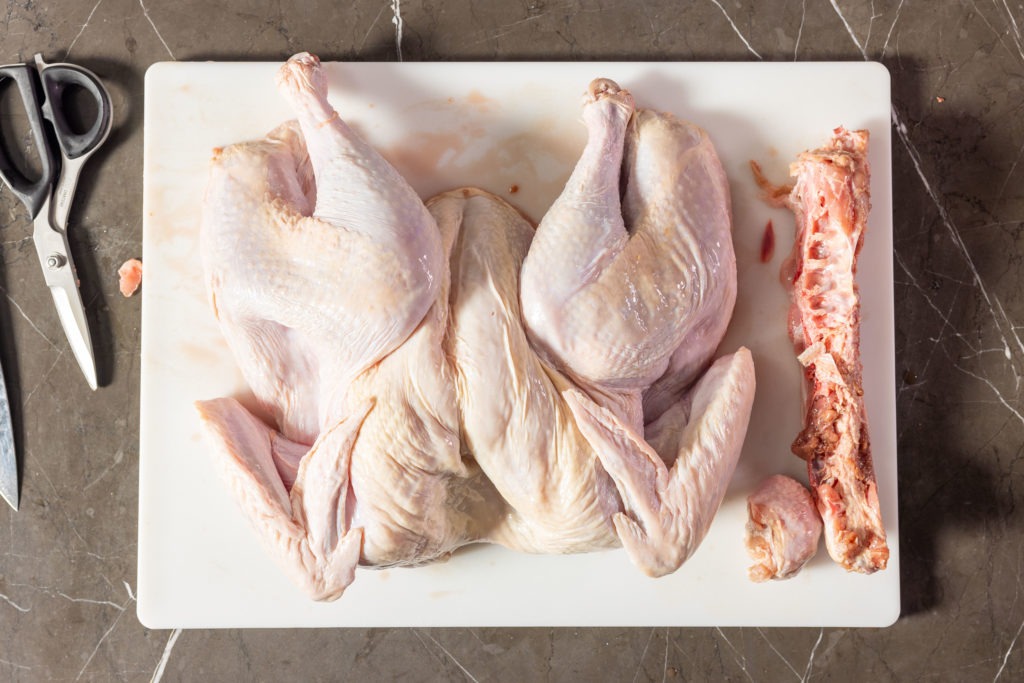The turkey is the star of the show on Thanksgiving Day, golden and juicy. But it can also be problematic. It takes up space in the oven, for one thing. Apart from the fact that it is frequently overcooked and half of the skin—which we want to be extremely crisp—is soaked and squidgy at the bottom of the bird, doesn’t that bird know you have sweet potatoes, rolls, and green bean casserole waiting in line? However, laying the bird flat while roasting is a simple yet incredibly effective time-saving tip. Continue reading if you’re the kind of person who prefers the unconventional and thinks outside the box. This fast-roasting turkey method is for you.
Though its etymology is unclear and up for debate, most agree that the word “spatchcock” originated in Scottish or Irish usage. No matter its origin, when the term is applied to whole fowl, it is equivalent to “butterflying. In essence, we flatten the bird by removing the backbone and arranging the legs and wings around the breast, like rays shining out from a white-meat sun. We’ll go into more detail about the precise procedure below. This vastly increases the surface area, much improving it over the semi-spherical shape it originally inhabits.
We hear you asking, “But what about Grandfather bringing the perfect turkey to the table to carve it?,” and we guess that’s a legitimate question, but we would also like to remind people that Norman Rockwell was most known for his paintings rather than his cooking. We’re not the only ones who don’t think that cooking something just because it looks good is always the best option!
Tired of dry, unevenly cooked turkeys? Say goodbye to those Thanksgiving woes with the spatchcock method! This technique involves removing the backbone and flattening the bird, resulting in a faster cooking time, crispier skin, and juicier meat.
Why Spatchcock?
- Faster Cooking: By exposing more surface area, your turkey cooks up to 50% faster than traditional methods. This means less time in the kitchen and more time enjoying your meal.
- Even Cooking: No more dry breasts and undercooked legs! Spatchcocking ensures that all parts of the turkey cook evenly, resulting in perfectly juicy meat throughout.
- Crispier Skin: With all the skin facing upwards, you’ll achieve perfectly golden, crispy skin that everyone will rave about.
- Better Gravy: The removed backbone adds extra flavor to your gravy, making it richer and more delicious.
How to Spatchcock a Turkey:
- Gather your tools: You’ll need a cutting board, poultry shears, and a sharp knife.
- Pat the turkey dry with paper towels.
- Place the turkey breast-side down on the cutting board.
- Cut along one side of the backbone with the poultry shears, starting at the tail and working your way up to the neck.
- Repeat on the other side of the backbone, removing it completely.
- Turn the turkey over and press down on the breastbone to flatten it.
- Tuck the wings behind the breast to keep them from burning.
Spatchcocking Tips:
- Watch a video tutorial for a visual guide on how to spatchcock a turkey.
- Use a sharp knife to ensure clean cuts.
- Don’t be afraid to get your hands dirty! Spatchcocking is a hands-on process.
- Season the turkey generously with salt, pepper, and your favorite herbs.
- Place the turkey on a wire rack over a baking sheet to allow for even heat distribution and prevent the skin from sticking.
- Roast the turkey at 425°F until the internal temperature reaches 155°F in the breast and 165°F in the thighs.
- Let the turkey rest for 20 minutes before carving to allow the juices to redistribute.
Additional Resources:
- Spatchcocked Turkey Recipe: https://www.seriouseats.com/butterfiled-roast-turkey-with-gravy-recipe
- Spatchcocked Turkey: The Best Turkey Ever, in Record Time!: https://blog.thermoworks.com/turkey/spatchcocked-roast-turkey-record-time/
Spatchcocking your turkey is a game-changer for Thanksgiving. With this method, you’ll achieve a perfectly cooked, juicy bird that everyone will love. So ditch the traditional method and give spatchcocking a try! You won’t regret it.
Spatchcocked turkey roasting temp
Once your bird is well flattened, it’s time to roast. Cook your bird at 425°F (218°C) until it reaches an internal temperature on your ChefAlarm® of 155°F (68°C). (If that doesn’t seem low, check out our piece on chicken internal temperatures; the ideas are the same for both chicken and turkey.) We promise that a turkey cooked to that temperature will be much more juicy than one cooked to a higher temperature. ) Verify that temperature with your Thermapen® ONE to make sure you don’t find any lower temperatures. If you don’t, you’re done! Chances are you’ll have cooked a 16-pound turkey in about 90 minutes. Wow!.
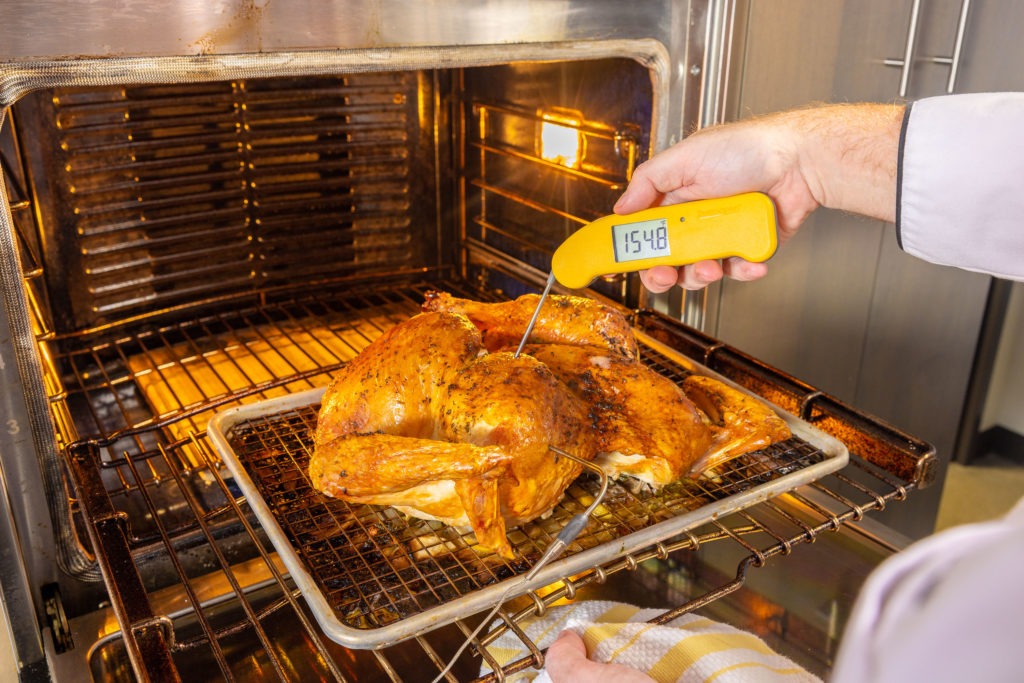
We hope you give this unorthodox turkey a try. It is superior in every manner and will give you a turkey that people will like to eat rather than just act interested in. Stick to our recommended temps, don’t forget the aromatics, and you’ll be crowned Thanksgiving royalty, for sure.
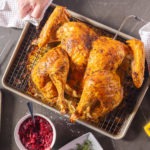
Preferred by people who know
Mark Bittman of the NY Times, and the author of How to Cook Everything, once put together a minimalist Thanksgiving dinner to cut down on prep, cook time, and ingredients so he could have time and energy to actually enjoy the meal with family and friends. This method was part of it. Bittman’s first spatchcocking video made its appearance in 2008. Since then a number of celebrity chefs have also applied the same method, with spatchcocking becoming an official foodie trend by 2012.
Kenji Lopez-Alt is another chef who swears by a flat bird! His discussion about and recipe for a spatchcocked turkey and many others can be found in his book, The Food Lab.
Cook after cook, professional after professional—people who know prefer the spatchcock method.
- It Saves Time: Mark splits and flattens the turkey to reduce the amount of time needed to roast it. The turkey flattens out, increasing its exposed surface area and decreasing its overall thickness to a nearly uniform level. By using this preparation, you can accelerate the cooking process by blasting the turkey at a higher oven temperature. Depending on the size of the bird, complete cooking could be completed in as little as 45 minutes. Spatchcocking tackles the problems of oven space as well as time. You’ll still have space in the oven for pies, rolls, and other baked goods after the turkey has been flattened.
- Turkeys with flat shapes have trouble cooking evenly because they are almost spherical in shape. When a turkey is spatchcocked, its legs are much more exposed than when it is in its natural shape. This is fantastic because the temperature of the dark meat in the breast must be higher than that of the light meat.
- Crispier Skin and Juicier Meat: When a bird is spatchcocked, its entire skin is exposed and facing up. This will produce a turkey with skin that is perfectly crisp and evenly browned throughout. The juices that come out of the skin keep the meat nice and moist.
- Improved Gravy: By taking out the backbone, you have an additional way to flavor your gravy. Use the neck, giblets, and backbone to quickly make a stock, and then combine it with the turkey drippings to make your gravy. There’s no need to make the gravy with store-bought chicken stock. (Not that your bird will require gravy—you won’t But you will need some for your potatoes. ).
- The Drippings: Oh, the drippings! Arrange carrots, celery, onion, parsnip, turnip, green apple, herbs, and lemon in the bottom of your sheet tray. As your bird cooks, its juices and butter—oh, the butter—dribble down into a hot pan full of flavorful goodness rather than the bird’s own cavity. The vegetables simmer and sauté in the juices to create the most delicious pan sauce ever. No need for thickener, no need for gravy. You won’t want to cook your bird any other way once you dip the meat in it and use it to scoop up the veggies.
Disadvantages:
We’ve covered all of the benefits of this technique, so what are the disadvantages? The most frequent criticism of spatchcocking is that it “just doesn’t look right.” Well, we’ve already established that we don’t need to hold onto that piece of ill-gotten nostalgia. The only real drawback is the anatomical aspect of the process. It could be deemed … unpleasant. For the squeamish. But really, it’s quite satisfying once you give it a try.
Enough talk about why spatchcocking is so great. You just need a chef’s knife, poultry shears, and a cutting board. It’s much simpler than you might think! As long as you’re not squeamish to the sound of bones breaking, it’s a cinch.
Follow These Easy Steps:
- Lay the turkey, backbone side up, on a chopping board after patting it dry.
- Using poultry shears, make cuts on both sides of the backbone, beginning at the bottom and working your way up to the neck. Use a knife to cut through any material that the shears are unable to cut through. You have now removed the backbone. Set aside to use when making your gravy.
- Make one incision on each side of the breastbone or down the middle of it. Turn the turkey breast side up.
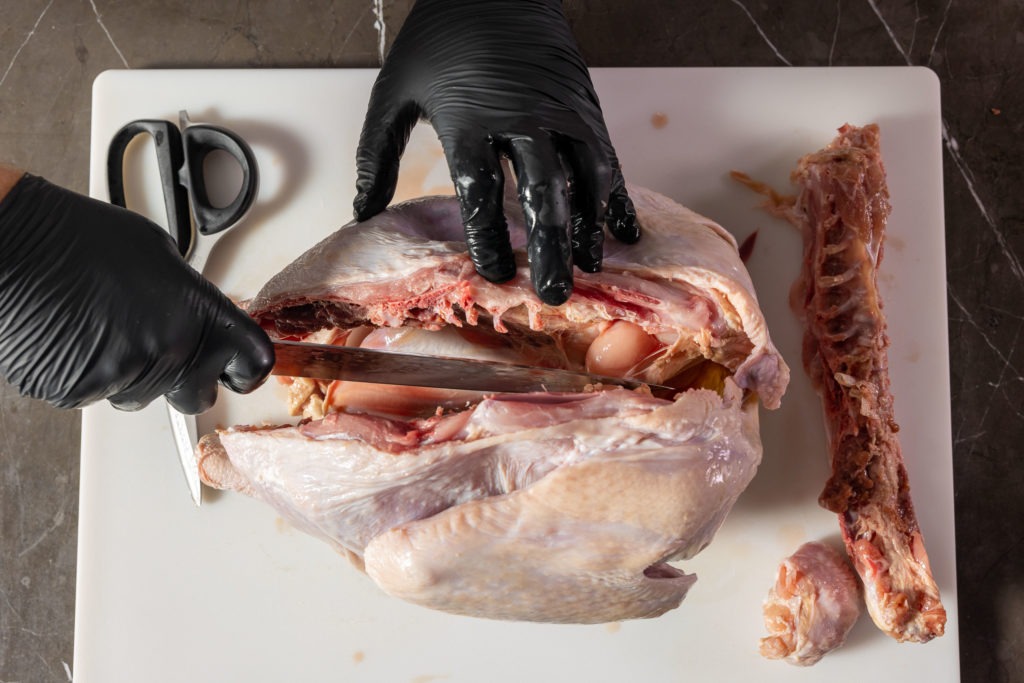
- Using your palms, flatten the bird and break its breastbone (ribs will break as well). Perhaps you should use a stool to gain more leverage.
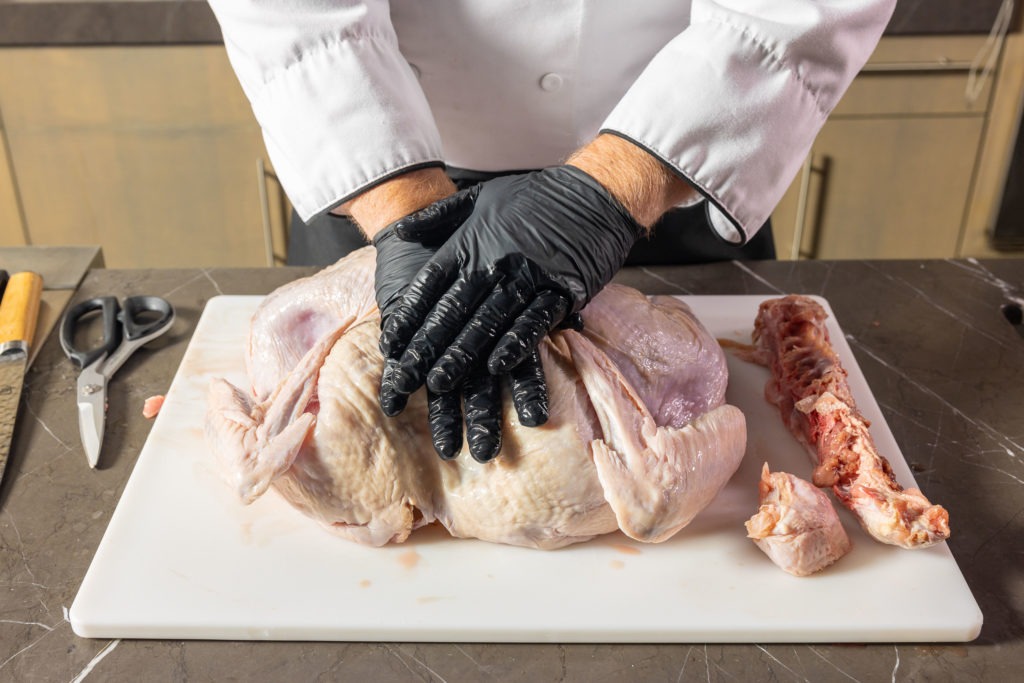
- Move the legs out to the side and tuck the wings under. Trim the excess neck skin. Your bird is now spatchcocked and ready to go.
